|
-
9th January 13, 08:15 PM
#1
43rd (Highland) Regiment of Foot
I am interested in constructing an authentic looking majorís uniform for the 43rd (Highland) Regiment of Foot (RoF). The 43rd RoF is the immediate successor of a number of the independent Highland companies and predecessor of 42nd RoF (eventually a Royal Highland Regiment and later called the Blackwatch). I know there are many Blackwatch reenactors but am unaware of any 43rd RoF reenactors.
I am very interested in contacting others who are interested in the 43rd RoF, or who may be able to guide me what an authentic 43rd RoF uniform looked like. (I can only go so far by looking at the pictures in the Osprey book on Highland Regiments .) .)
Regards,
Steve Buchanan
Sydney, Australia
-
-
10th January 13, 04:10 AM
#2
I think that you should get some useful info via some of the rabble on the jacket and accoutrements but the tartan is more difficult and something that's never been tied down with any certainty. A fact not helped by the lack of contemporary specimens, accurate portraiture or surviving regimental records.
It seems certain that the original dress was the feileadh mor and most writers follow Stewart of Garth's view that the current Government sett was designed at the time that the Independent companies were regimented in 1739 but elsewhere Garth talks about a red line being included at the behest of Col Murray. Irrespective of the actual sett; Government or Government plus red line (i.e. Murray), the shades at the time would not have been as dark as those used by the military since about 1880 and still seen today in the RRSís version Ė Government 1A.
-
-
10th January 13, 11:10 AM
#3
i had a quick search on the interweb and found this:
Accordingly, six independent companies of Highlanders were formed : three companies, consisting
of 100 men each, commanded respectively by Lord Lovat, Sir Duncan Campbell of Lochnell, and
Colonel Grant of Ballindalloch, who were granted captain's commissions ; and three companies of
75 men each, of which Colonel Alexander Campbell of Finab, John Campbell of Carrick, and
George Munro of Culcairn, were appointed " captain-lieutenants." Two lieutenants and one ensign
were posted to each company. 1
The independent companies wore the clan tartan (consisting mostly of black, blue, and green)
of their respective commanders, and from their sombre appearance were designated Am Freiceadan
The rest can be found here http://archive.org/stream/historyof4...vuoft_djvu.txt
Hope it helps
-
-
10th January 13, 07:51 PM
#4
David,
Thank you for this link. I have extracted what I think are the salient points:
HISTORY OF THE 42ND ROYAL HIGHLANDERS-" THE BLACK WATCH", NOW THE FIRST BATTALION, "THE BLACK WATCH" (ROYAL HIGHLANDERS)
By LIEUT.-COL. PERCY GROVES, R.G.A., Pub, W. & A. K. JOHNSTON, EDINBURGH AND LONDON, 1893
“The establishment of a Regiment of the Line from the Independent Black Watch Companies … a letter of service, dated 25th October 1739, was addressed to the Earl of Crawford and Lindsay, authorising him to raise the additional companies and embody the new regiment, of which he was appointed Colonel.” p2
In 1749, the Regimental number was changed from 43rd to 42nd. p6
The uniform of the Highland Regiment consisted of a scarlet jacket and waistcoat with buff facings and white lace; a tartan plaid of twelve yards plaited round the middle of the body, the upper part being fixed on the left shoulder ready to be thrown loose, and wrapped over both shoulders and musket in wet weather. This was called the “belted plaid," and was worn on full dress parades and duties; but in barracks, and when not on duty, the philibeg, or little kilt, was worn.
The head-dress was a blue bonnet bordered with white, red, and green, arranged in small squares, to resemble, as is said, the fess chequey in the arms of the Stuart families; a tuft of feathers, or sometimes a tuft of black bear-skin, was afterwards added. Tartan hose, with buckled shoes were worn; the purses were made of badger-skin.
The officers' dress-coats were slightly embroidered with gold; the sergeants' jackets were trimmed with silver lace which they provided for themselves.
Lord Crawford, being a Lowlander, had no family tartan, so a special pattern was designed for his regiment, which has ever since been known as the "42nd tartan." Government furnished muskets, bayonets, and basket-hilted broadswords for the men, who were permitted to retain their pistols, dirks, and targets. The sword-belt was of black leather; the cartouche-box was worn in front supported by a waist-belt. 1 The officers carried fusils, or short muskets, after the fashion of officers of fusilier and light-infantry corps; the sergeants retained their formidable Lochaber axes. p2f
A red stripe was added to the tartan of the 1746 by the Regiment’s Colonel, Lord John Murray, to distinguish the Regulars (43rd) from the Independent Companies then being raised, in S. Reid’s, 18th Century Highlanders, Men at Arms Series, Osprey, 1993, p36
It is not clear to me when this red stripe was removed. I think I will stick with the contemporary Black Watch tartan.
I find the 12 yards of plaid interesting as Bob Martin, FSA Scot, Kiltmaker and Kilt Historian, cites in his book Know Your Kilt, that 3-4 yards of double-width was most common in the construction of feileadh-mors. Presumably, Groves meant 12 yards of single width paid, ie 6 yards of double width plaid – twice that cited by Martin. Reid also states that, depending on the rank of the wearer, 3-5 yards of double width plaid was used to make the belted plaid (ie feileadh-mor).
I must admit that I’m not sure what is meant by “The officers' dress-coats were slightly embroidered with gold.”
-
-
11th January 13, 10:23 AM
#5
This might be closer, in time at least - 1797 - you can find the details here http://www.tartanregister.gov.uk/qRe...tring=regiment
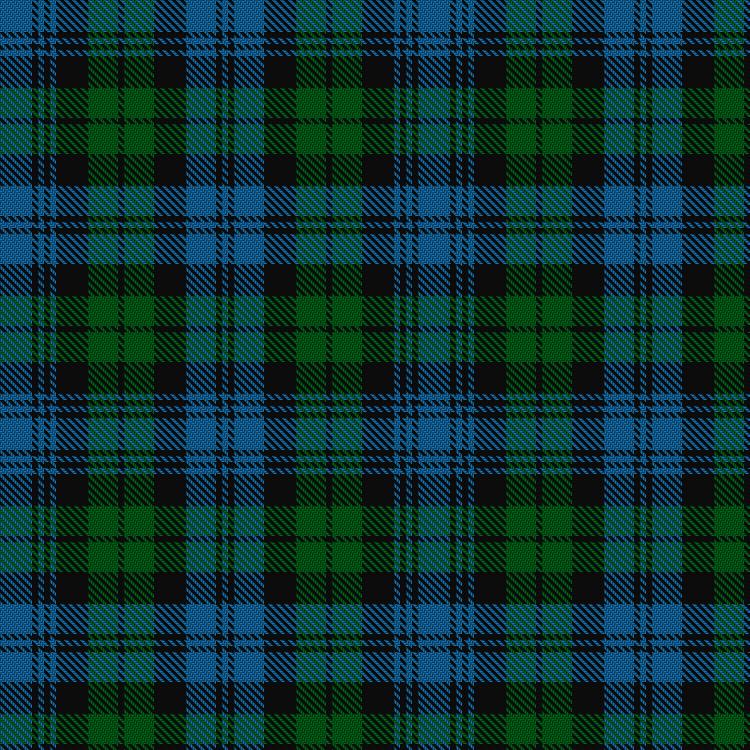
-
-
11th January 13, 10:29 AM
#6
Here is the thread count in case you are interested
Threadcount given over a half sett with full count at the pivots.
AB32 K6 AB6 K6 AB6 K32 G30 K6 G30 K32 AB30 K6 AB6
K=101010BLACK; DB=202060DARK BLUE; DG=003820DARK GREEN; G=006818GREEN; B=2C2C80BLUE; BB=3000C000U3; AB=1474B4BALMORAL BLUE;
Its a nice tartan. Interesting to me as the Argyll & Sutherland Highlanders wore it. My Great Grandfathers brother was in the A&SH and was killed in the last battle of the Somme, he has no known grave.
-
-
12th January 13, 11:24 AM
#7
 Originally Posted by figheadair

I think that you should get some useful info via some of the rabble on the jacket and accoutrements but the tartan is more difficult and something that's never been tied down with any certainty. A fact not helped by the lack of contemporary specimens, accurate portraiture or surviving regimental records.
It seems certain that the original dress was the feileadh mor and most writers follow Stewart of Garth's view that the current Government sett was designed at the time that the Independent companies were regimented in 1739 but elsewhere Garth talks about a red line being included at the behest of Col Murray. Irrespective of the actual sett; Government or Government plus red line (i.e. Murray), the shades at the time would not have been as dark as those used by the military since about 1880 and still seen today in the RRSís version Ė Government 1A.
Here's a 42nd Genadier by David Morier c1751-60 which 'may' show the red line version of the sett.

-
-
12th January 13, 06:34 PM
#8
From earlier in the discussion on the 43rd RoF we know that the red stripe was added in 1746 (but we don't know when it was removed), and that the 43rd became the 42nd in 1749. To be honest and possibly much to the distress of purists, I'll probably end up using one of the modern Black Watch in one the more muted ancient styles (http://www.scotweb.co.uk/buy/tartan-...howtab=results) to create the Feileadh MÚr of my 43rd RoF uniform.
Unfortunately the the Army's 1742 Clothing Book shows little more than an artist's impression of the tartan.
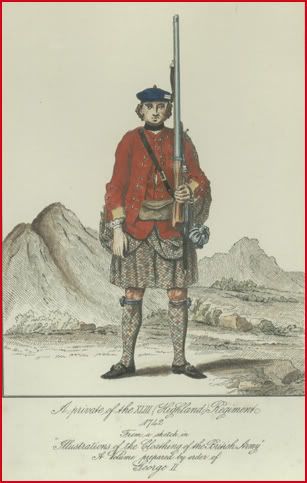
-
-
12th January 13, 09:19 PM
#9
The 1743 Mutiny resulted in three men being executed: Corporals Malcolm and Samuel McPherson, and Private Farquhar Shaw.
Lord John Murray, who was later Colonel of the Regiment, had portraits of all three men hung in his dining room.
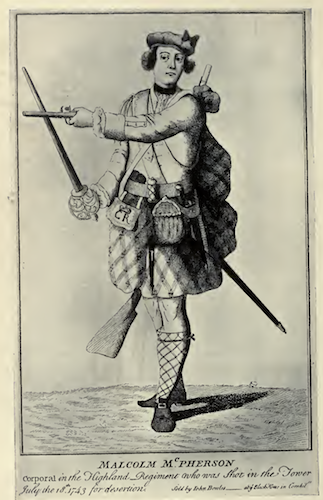 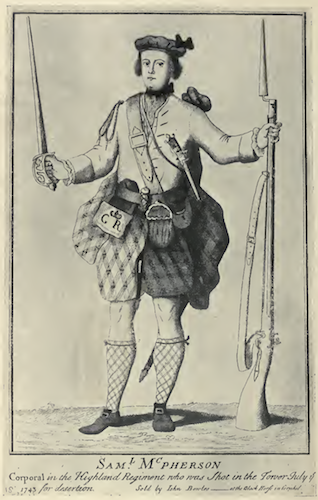 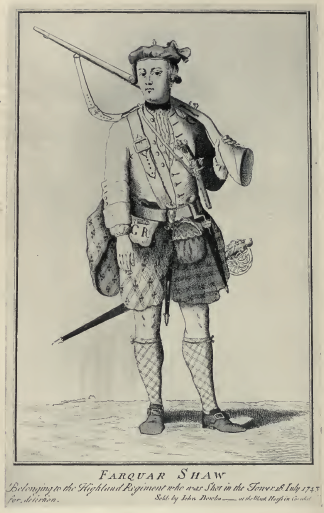
The drawings give contemporary illustrations of the uniform (presumably most artists draw what they see to the best of their ability). I can't but note that the tartans in all drawings are on the diagonal, as was the one from the 1742 Clothing Book. Was this just because the artist couldn't draw tartans, or is the something else going on?
-
-
12th January 13, 09:32 PM
#10
The subject of the first two drawings is Private Farquar Shaw, and the third drawing is of one of the Corporals McPherson.
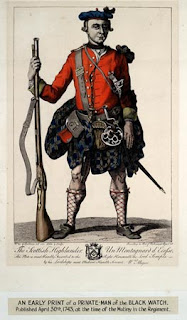  
-
 Posting Permissions
Posting Permissions
- You may not post new threads
- You may not post replies
- You may not post attachments
- You may not edit your posts
-
Forum Rules
|
|
.)
























Bookmarks